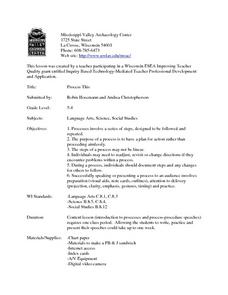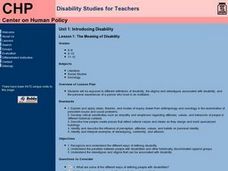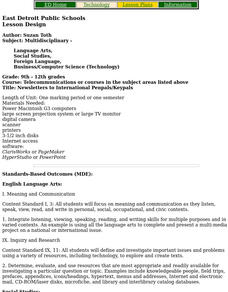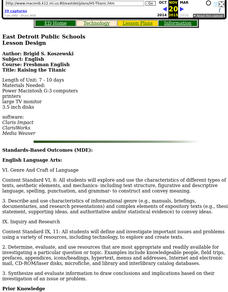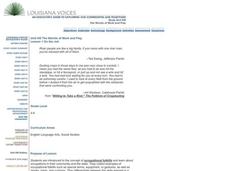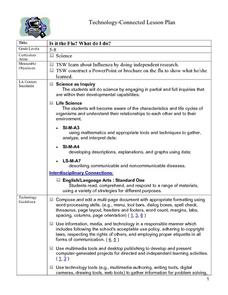Curated OER
Process This
Students chart the steps, including the problem-solving tangent, and discuss the idea of procedures serving to give us a "road map" or guide to help tackle tasks with preparation and forethought.
Curated OER
Click, Clack, Moo: Electric Blanket Science
Students read Click, Clack, Moo: Cows That Type by Doreen Cronin and discuss the similarities and differences between electric blankets and regular blankets. They brainstorm a list of reasons why the farm animals wanted electric blankets.
Curated OER
The Meaning of Disability
Students discover the different types of disabilities. They examine the stereotypes and stigmas associated with them and hear from a person who lived in an institution.
Curated OER
Alberta And Saskatchwan: the View in 1905
Students analyze the differences between maps 1905 and current maps of Alberta and Saskatchewan. They use maps from the Canadian Council for Geographic Education to complete a guided inquiry. This lesson also has many extension activities.
Curated OER
Newsletters to International Penpals/Keypals
Students participate in an intercultural E-mail exchange throughout a semester. They send newsletter to international penpals/keypals.
Curated OER
American Literature - The American Dream: Past, Present, and Future
Students are introduced to the ideas of the American Dream at the turn of the century. They present their ideas on the American Dream at the turn of the century through a person characterized in Edgar Lee Masters' Spoon River Anthology.
Alabama Learning Exchange
Alabama Biographies of the 20th Century
Students research and examine the lives of famous people who have changed the history of Alabama. They write a short biographical summary and create a 3-D scan picture.
Curated OER
Raising the Titanic
Ninth graders research the history of a person who was aboard the Titanic and write about the part he/she played in the world's greatest maritime disaster.
Curated OER
Rudolfo Anaya
Students read and analyze the Rudolfo Anaya novel Bless Me, Ultima. They discuss passages from the book, watch a video, view and analyze a mural of Mexican American artwork, and write a journal response.
Curated OER
On the Job
Learners identify the concept of occupational folklife and learn about occupations in their community and the state. Then they collect examples of occupational folklife such as special terms, equipment, or gestures, as well as stories,...
Curated OER
Pictures of the Berlin Airlift: Primary Sources (Photos and Cartoons) to Motivate Learning
Tenth graders describe cartoons and photos from the Berlin Airlift and put them into a historical context. After a lecture/demo, each pair of students be asked to describe what they see in the photos. They then write a caption for each...
Curated OER
Louisiana Regional Foodways
Learners strengthen their research techniques in locating, selecting, and synthesizing information from a variety of texts, media, references and internet resources to study regional food way traditions in Louisiana. They assess the...
Curated OER
Canada and its Trading Partners
Students identify the relationship between Canada and its trading partners. They use two data sources, Canadian Statistics and E-STAT, on the Statistics Canada website to explore the growing importance of trade in general.
Curated OER
Riot, Revolution and Reform
Students examine the student protests and subsequent massacre at Tiananmen Square in 1989 and the current petition by victims' family members to open a criminal investigation of the responsible officials.
Curated OER
Make It or Break It
Students study about "breaking news" by analyzing the New York Times' coverage of the July 2006 bombing of seven commuter trains in Mumbai, India. They write their own breaking news stories for homework.
Curated OER
It's All Greek to Me!
While the ideas for Ancient Greek research are solid, there is little detail to help make your job easier. The focus here is familiarizing your class with online databases and print resources in their school library. After direct...
Curated OER
Making Your Own Master Calendar
Ninth graders discuss time demands such as homework, family, and chores that occupy their free time. They discuss how to effectively manage their time. They write important information and activities on a calendar. They develop and...
Curated OER
ADULT ESOL LESSON PLAN--Level 2--Telephone Communication
Students, after extensively reviewing the vocabulary list on the board, examine the form of communication that deals with all the aspects of a telephone: telephone bill, customer service, billing and disconnection/reconnecting fees.
Curated OER
The ABC's of Artifacts
Students create their own ABC book about artifacts. In this artifact lesson, students read ABC History Mystery and review the artifacts pictured in the book. They create their own ABC book with each student working on a letter.
Curated OER
Is It The Flu? What Do I Do?
Students use the internet to research the flu. Using various websites, they identify who should get flu shots, how to protect themselves and guidelines for getting over the flu. They write a one page report on their findings to end the...
Curated OER
Can We Live Without Paper?
Learners create a story, skit, or storyboard to express their thoughts on a world without paper. For this paper lesson plan, learners learn how their lives would be affected if we didn't have paper.
Curated OER
King Phillip's War: A Primary Source, Exploring Options, and Sachem's Speech Writing Activity
Students study the causes and effects of King Philip's War. In this Native American history instructional activity, students examine the options that the Native Americans had in 1676 New England. Students weigh the pros and cons of the...
Curated OER
Roaring Twenties: The Impact of High School on its Students Over Time
Eleventh graders compare the American high school experience of the 1920's to today. In this historical perspectives lesson, 11th graders examine surveys from 1924 high school students and then create their own surveys for today's high...
Curated OER
Traveler's Trunk
Students analyze and interpret artifacts from the 1920s and explore the Great Migration. In this 1920s history lesson, students review background information about the Great Migration and use artifacts to study history of Chicago....


